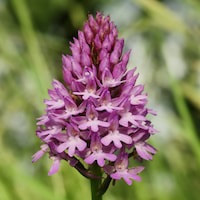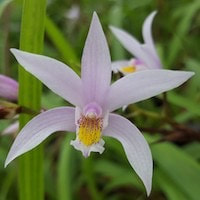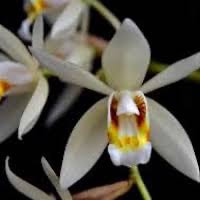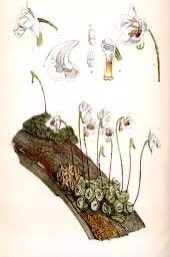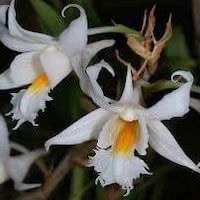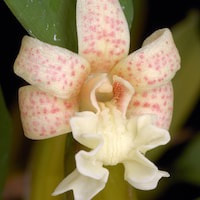WFL6 - Women's Floral 6 - The strawberry Effect
|
Native Singaporean Orchid notes: Phaius Tankervilliae
Phaius tankervilliae, featured in Floral 6 (Women) for a perfume workshop, is a large orchid known for its impressive size and scent. With oval leaves up to a meter long and flowering stems that can reach 2 meters, this orchid produces some of the largest flowers among Australian orchids, displaying reddish-brown and white colors. It blooms mainly in spring and has cultural uses, such as in Papua, where smoked flowers are consumed as a contraceptive. Despite being invasive in places like Jamaica and Hawaii, Phaius tankervilliae is admired for its beauty and fragrance, often mistaken for native Hawaiian flowers.
|
Therapeutic Orchid notes:
|
Anacamptis Rich
Anacamptis Rich, named from the Greek word for “to bend back,” is an orchid genus with around a dozen species found in grasslands from northern Iran to southern and central Europe. These orchids are known for their tubers, which are harvested to make salep, a historical substance valued as an aphrodisiac and super-nutrient in Europe. The tubers’ aromatic qualities are used in perfumes, adding a sophisticated and alluring scent. Anacamptis Rich combines cultural significance with a captivating fragrance in the world of fragrances. |
|
Bletilla formosana
Bletilla formosana, known as Taiwanbaiji, hyacinth orchid, and white rhizome orchid, is an orchid with a rich history in traditional Chinese medicine (TCM) for its healing properties. In TCM, its stems are used to strengthen the lungs, control bleeding, and reduce swelling, treating conditions like cough and bleeding ulcers. In India, the stem scrapings are applied to heal cracked heels. The orchid contains compounds with antimicrobial effects against harmful bacteria, highlighting its medicinal value and making it a significant plant in traditional medicine practices. |
|
Coelogyne flaccida Lindl.
Coelogyne flaccida Lindl., also known as Lilinbeimu Lan or Guishangye in Chinese and Jidatui in Chinese medicine, is a significant orchid used in traditional medicine. This orchid, found in Guizhou and Yunnan in China and known as Thur gava in Nepal, contains compounds like flaccidin and sofaccidin that offer health benefits. It is used to clear heat, relieve coughs, and alleviate headaches and indigestion. The plant’s medicinal uses and unique scent highlight its cultural and therapeutic importance in various regions. |
|
Conchidium muscicola (Lindl.) Rausch.Syn. Eria muscicola (Lindl.) Lindl.
Conchidium muscicola, also known as Jivanti in Sanskrit, is an orchid with significant cultural and medicinal importance. The name "Jivanti" means "life-giving" in Sanskrit, reflecting its use as a tonic for rejuvenation and health. In traditional medicine, its pseudobulbs are used in India and Nepal to treat heart and lung conditions, nervous system disorders, and other ailments. Beyond its therapeutic uses, the orchid’s scent adds charm to fragrances, making it a notable herb in both traditional medicine and perfumery. |
|
Dendrobium longicornu Wall ex Lindl. Syn. Dendrobium bulleyi Rolfe, D. flexuosum Griffith, D. hirsutum Griffith.
Dendrobium longicornu, also known as Changju Shihu in Chinese and Bawar or Kause in Nepali, is an orchid found in regions like Guangxi, Yunnan, Tibet, Nepal, Bhutan, Sikkim, northeast India, Myanmar, and Vietnam at high elevations. The plant's stems contain unique compounds that give it a special fragrance and potential health benefits. In traditional medicine, it is used in Chinese and Nepali remedies to treat fever and coughs in children and livestock. Its aroma and medicinal properties make it a valued ingredient in perfumes and herbal treatments. |
|
Dendrobium macraei Lindl. Desmotrichum fimbriatum Bl., Flickingeria fimbriata (Bl) Hawkes
Dendrobium macraei, also known as Liusujin Shihu in Chinese and Jivanti or Jibanti in India, is an orchid with rich cultural and medicinal uses. It blooms in March, showcasing vibrant flowers and a captivating fragrance. In traditional medicine, this orchid is used as a tonic and aphrodisiac, and is included in the sweet delicacy "Halwa" in India. It treats ailments like asthma, fever, and sexual dysfunction in Nepal, and is used in Sri Lanka for medicinal massage oils. Its scent and therapeutic properties make it valuable in both traditional remedies and perfumery. |
Other scent note
Scentopia Library Reference ingredient
Lily - Check details at Scentopia's scent library
Download the guided mediation that works best with this Orchid fragrance oil
| women_floral_essential_oil_orchi_00006.mp3 | |
| File Size: | 156182 kb |
| File Type: | mp3 |

